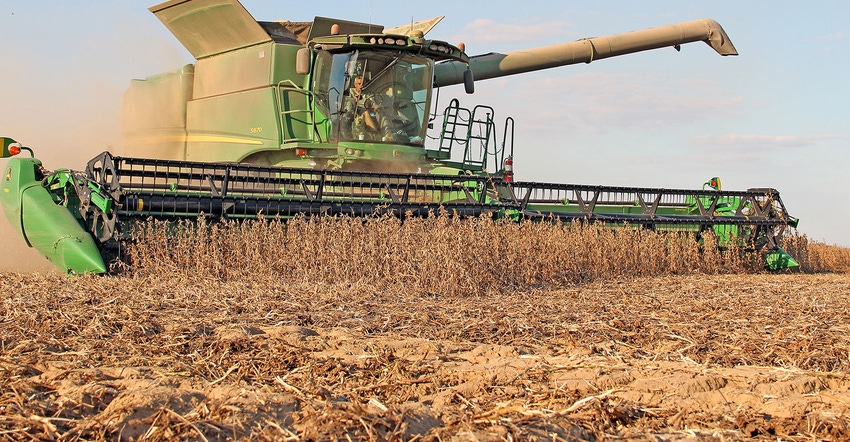May 28, 2019

U.S. soybean ending stocks are expected to reach near-record levels for the second year in a row in the 2019-20 marketing year beginning this fall, according to forecasts by USDA agricultural economists.
As a result, the economists are predicting a season-average price for soybeans of $8.10 per bushel for 2019-20, the lowest since the 2006-07 marketing year when the season-average price for the commodity was $6 per bushel.
This is expected to occur despite a projected decline of more than 4 percent for soybean plantings this spring and a 9 percent decline in production this fall, said Rachel Trego, an international economist with USDA’s Foreign Agricultural Service in Washington. She is the team leader for food grains analysis.
Her comments came in a Food and Agribusiness Webinar conducted by the University of Arkansas System Division of Agriculture. The webinars, hosted by Dr. Bobby Coats, a professor in the Department of Agricultural Economics and Agribusiness at the University of Arkansas, feature presentations on the latest issues in agriculture. To view, visit https://bit.ly/2K1BPjf.
When USDA released its World Agricultural Supply and Demand Estimates on May 10, economists were expecting 2019 corn acreage to be nearly 4 percent higher due to the more favorable price outlook for corn versus soybeans.
“Corn stocks, while burdensome, are not at record levels, but they have increased quite a bit from 2012-13 when supplies were much tighter,” she said. “The stocks for corn are expected to be their largest since the 1980s. Soybean stocks for 2019-20 are expected to be slightly below the record that is expected at the end of the 2018-19 marketing year, which ends in August.”
Projections could change
Some of those projections could change due to the weather conditions in late April and early May.
“It has been a very wet year for the country,” she noted, displaying a map showing there were almost no drought conditions across the U.S. as of May 16. Poor weather conditions last fall also contributed to a decline in winter wheat acres, which are the smallest since USDA began compiling records in 1909.
“We have seen a multi-year decline in U.S. winter wheat planted area,” Trego said. “In terms of the decline from last year, this map of the United States shows that 10 states have seen major declines in winter wheat seedings, while 11 have seen increases. In the largest producing state, Kansas, we saw a decline of 700,000 acres due to wet conditions.”
While some areas have seen good growing conditions this spring, others have experienced unusually heavy rainfall, delaying many growers in the Mid-South and Midwest from meeting normal planting dates.
USDA is predicting 2019-20 U.S. corn production at 15 billion bushels, which would be the second largest on record behind 2016-17.
The 2019-20 U.S. soybean crop is forecast to decline to 4.15 billion bushels, down 394 million bushels from last year’s record crop due to reduced acreage and trend yields.
“I want to note these production estimates are taking into account the weather-adjusted trend yield going back 30 years,” she said.
Weather slowed planting
“We have had wet spring weather, which has slowed planting across the country except for peanuts. And, as a result, crop development has been delayed. (Corn plantings were at 50 percent on May 19 versus the five-year average of 80 percent for that date. Soybeans were at 20 percent vs. 50 percent.)”
Despite the uncertainties generated by the U.S.-China tariff war, USDA is forecasting U.S. soybean exports will increase in 2019-20.
“This is expected as the U.S. share of global trade could rise from the current year (2018-19) to 35 percent in 2019-20,” she said. “For corn, exports are forecast down 1 percent, taking into account increased feed and residual use in the United States and increased industrial use and stronger competition from South America.”
USDA expects wheat exports to be down 3 percent due to stronger competition from major exporters such as the European Union and Russia. U.S. exports are forecast to rise for sorghum, cotton and rice.
“For cotton, the exports are up 15 percent on a much larger crop, and sorghum exports are forecast up 18 percent.”
“The global soybean production is down and that is largely with the U.S. forecasted down,” Trego said. “If you look at global soybean production you will see that about a third is within the U.S., a third within the Brazil and a third within the rest of the world. With the U.S. expected down, that will be a key driver for global soybean production decline.”
World import demand
World import demand outside China has increased, although China is still importing more than half of the global soybean supply. “But that demand has gone up based on additional investments that have been made in countries to increase their ability to crush soybeans for meal and oil,” she said.
“For China that crush is flat year-to-year, but the rest of the world is seen to be increasing, including India, which has been exporting much of its soybean meal and is now consuming more of that domestically. Some of its neighbors, including Pakistan and Bangladesh, have made investments that enable them to import crush there.”
She said USDA economists are also seeing significant investments in the Middle East and North Africa, especially in Egypt and Tunisia, where the crush investments are continuing to be made to supply the growing livestock and poultry and aquaculture sectors.
“One of the key questions is what the underlying feed demand is for China,” she noted. “When we look at total protein demand, we see that for both 2018-2019 and 2019-20, it expected to be lower than the peak that we saw in 2017-18. This reverses a multiyear trend that we had seen of continued annual growth of 5 percent.”
About the Author(s)
You May Also Like






